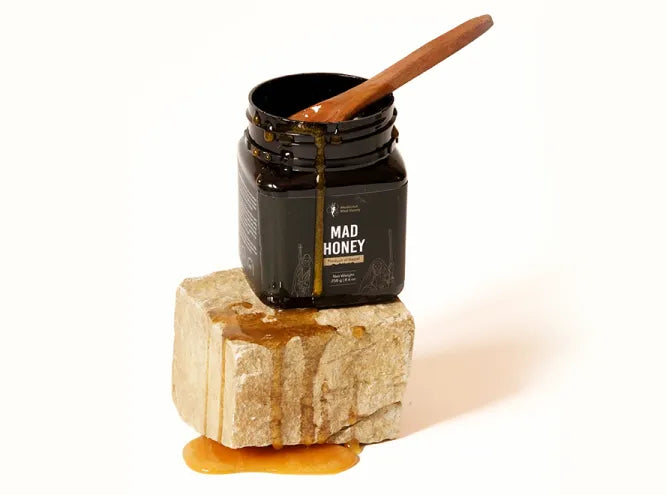Commercially available honey that we consume daily is generally from Apis mellifera (Western honey bee). Besides these makers of what is normally served in our kitchen, more species of bees make and store honey as their food source to be used later.
Yes, bees have their own purpose of making honey, they do it for their own survival, especially to feed the growing brood and the whole hive during nectar scarcity. As this is a way of adaptation for survival, almost all social bees store a large amount of honey in their hive.
One such unique bee species making honey is Apis laboriosa, the protectors and preservers of the ecosystem in high altitudes where most of the common bees hesitate to settle. They are known for making mad honey, an intriguing name for the psychoactive properties the honey holds!
Apis- Honey Making Champions

Apis produce 90% of the honey that we’ve been consuming worldwide. Some common bees that contribute to global honey production are:
-
Apis mellifera: Western honey bee, it’s used in commercial beekeeping; this species is the most common globally.
-
Apis cerana: Eastern honey bee, it’s common in Asia.
-
Apis dorsata: Giant honey bee, it’s native to Asia.
-
Apis florea: Dwarf honey bee, it’s found in Asia and the Middle East.
-
Apis laboriosa: Himalayan Giant Honey Bee, it’s from the high altitudes of the Himalayas.
Some Unexpected Honey Makers

Bees other than Apis also prepare honey. Though smaller in quantities, what these bees make is no less precious- it sustains their colonies
Meliponini tribe/ Stingless bees
These bees are stingless, without stingers. They’re unique in that they produce pot-honey, honey stored in pot-like structures rather than hexagonal combs. The tribe contains some notable species:
-
Melipona beecheii: Highly medicinal honey is produced, used by the indigenous community Maya to treat ailments in the body since traditional times.
-
Trigona species: Trigona is one of the largest species of stingless bees. The special feature about this bee species is that they are true protectors of their hives, they respond aggressively when intruders try to damage their hive.
-
Tetragonula carbonaria: These bees are native to Australia and are known for the tangy flavors of honey they produce.
Bumblebees
Bumblebees are wild bees, they source the nectar from wildflowers blooming amid the wildflower-rich landscapes. The honey they produce in small amounts is not for commercial purposes, the sole reason behind the production is only to keep the generation thriving.
Rare/ Expensive Honeys
Mad Honey- found in the highest elevations, rare.
Elvish honey- most expensive, harvested from deep cave hives.
Pitcairn honey- rarest honey.
Manuka honey- unique and rare.

The Science of Honey Production
Despite the existence of several kinds of honey bees, the way each of them produces honey is the same. Here is a step-by-step guide on how honey is produced:
- Forager bees collect the nectar.
- Forager bees pass it to house bees, where all the complex sugars get converted by enzymes present on their mouthparts to simple sugars: glucose and fructose.
- The simplified form is then spread into honeycomb cells.
- What has been deposited changes composition-wise, water content is reduced by 50 to 60%. The bees fan their wings for this, creating a viscous form.
- As the right consistency is maintained, now bees cap each honey-stored cell with a thin layer of beeswax.
- When the time of usage arrives, the beeswax is chewed open by the bees.
Why Some Species Don’t Produce Honey?
Not all bee species produce honey- and there are good evolutionary reasons for that. Firstly, not all species are social and the ones in solitary mode don’t need stored nutrients to feed their hive. Secondly, making honey and storing it is an energy-intensive process. So, all the species with high, long-term energy needs invest in it.
Finally, if the bees can find the nectar all around, they won’t get involved in honey making as it is unnecessary.
FAQs
Q. What is the species diversity of the honey bee?
A. When we mention the honey bee, it specifically comes down to the Apis species. There are around nine species of Apis, the most common ones being A. mellifera, A. cerana and A. dorsata.
Q. Are all bees making honey?
A. No, not all bees are making honey. Among 20,000 bee species, about nine species of Apis and a significant number of stingless bees make honey.
Q. How many different types of honey bees are there?
A. The true honey bees are Apis species, which are around nine in number. Besides that, stingless bees of the Meliponini tribe also make honey, but in small amounts.
Q. Which bees don’t make honey?
A. The bees living in a solitary mode don’t produce honey. The nectar they collect is enough to feed their offspring.
References:
https://www.icimod.org/initiative/about-bees-and-pollination/
https://www.researchgate.net/publication/304011787_Honey_Types
https://bestbees.com/bee-species-types-of-bees/
https://agritech.tnau.ac.in/farm_enterprises/fe_api_typesofhoneybee.html





